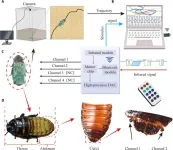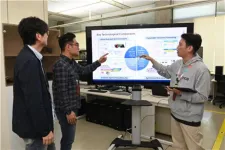(Press-News.org) Genetic variants linked to a rare form of bicuspid aortic valve disease that affects young adults and can lead to dangerous and potentially life-threatening aortic complications have been identified by researchers at UTHealth Houston.
The study was published today in the American Journal of Human Genetics.
“We previously found that young individuals who present due to early onset thoracic aortic dissections are more likely to have bicuspid aortic valves and more likely to have rare variants in bicuspid aortic valve-associated genes,” said Siddharth Prakash, MD, PhD, co-principal investigator of the study and associate professor of medical genetics and cardiovascular medicine in the Department of Internal Medicine at McGovern Medical School at UTHealth Houston. “When we observed that bicuspid aortic valve is kind of a risk marker for this group with bad outcomes, we specifically wanted to see whether young individuals who present clinically due to problems related to bicuspid aortic valve disease may also have rare genetic variants that predict complications such as needing valve surgery.”
About 1 in 100 people are born with a bicuspid aortic valve, making it the most common cause of congenital heart disease.
The comparison between the rare subgroup of early onset bicuspid aortic valve to the common population of the disease allowed researchers to determine which group of patients will benefit from genetic testing, enabling earlier, more aggressive treatment. According to researchers, patients with bicuspid aortic valve disease often wait too long to be seen, leading to more severe cardiovascular symptoms, such as heart failure and even sudden death.
A bicuspid aortic valve is a congenital heart defect where the value has two flaps, or cusps, instead of three, so the valve does not open and close properly with each heartbeat. This can lead to complications such as blocked, reduced, or backward blood flow through the heart chambers, causing shortness of breath, chest pain, fainting, and difficulty exercising. In more severe cases, the disease can lead to an aortic dissection, or tear in the aorta, a life-threatening condition.
Researchers studied individuals who presented with specific complications of the disease before age 30 or who were immediate relatives to someone with early onset bicuspid aortic valve disease. Early onset symptoms of the disease were defined as moderate or severe aortic stenosis or aortic regurgitation, a large thoracic aortic aneurysm, needing to have aortic surgery, or aortic dissection.
Researchers aimed to identify genetic variants that may lead to an increased risk of the disease in young adults. “The average person in this study was affected in their 20s and had relatives with the disease, so we traced the onset of the disease in the families and we reported rare genetic variants that segregated with the disease in these participants and their relatives,” Prakash said.
Prakash and his team analyzed whole-exome sequencing data, sourced from 215 families from over 20 institutions to identify the rare genetic variants known to cause congenital heart disease in early onset bicuspid aortic valve disease in this rare subgroup. They compared those findings to the more common population of patients with later-onset bicuspid aortic valve disease.
The identified genes included genes that cause isolated nonsyndromic bicuspid aortic valve, as well as other types of congenital heart disease that are associated with bicuspid aortic valve or related congenital malformations. Researchers found damaging variants of genes with moderate or strong evidence to cause developmental cardiac phenotypes in 107, or 50%, of affected families in the study.
“We showed that the older patients with bicuspid aortic valves are unlikely to benefit from genetic testing because they are unlikely to have these kinds of genetic variants,” Prakash said. “It's important for people to realize, as we saw in this study, that a lot of people with bicuspid aortic valves have affected relatives. In the future, family members may be tested for genetic variants that cause bicuspid aortic valve complications, and people who have these genetic variants could be treated early to prevent future complications from developing.”
The research was funded by the National Institutes of Health (R01HL137028, R21HL150383, R01HL114823, and R21HL150373). The University of Washington Center for Rare Disease Research provided sequencing and data analysis, funded by the National Human Genome Research Institute, grants U01 HG011744 and UM1 HG006493.
Dianna M. Milewicz, MD, PhD, professor of medical genetics, President George Bush Chair in Cardiovascular Medicine, and director of the Division of Medical Genetics at McGovern Medical School at UTHealth Houston, was a co-principal investigator on this study.
First author of the study was Sara Mansoorshahi, BA, McGovern Medical School. Additional authors included Dongchuan Guo, PhD, professor of medical genetics at McGovern Medical School; Dawn S. Hui, MD, The University of Texas Health Science Center at San Antonio; Shaine A. Morris, MD, MPH, Baylor College of Medicine; Angela Yetman, MD, University of Nebraska Medical Center; Malenka M. Bissel, MD, DPhil, University of Leeds; Yuli Y. Kim, MD, Hospital of the University of Pennsylvania and the Children’s Hospital of Philadelphia; Hector I. Michelena, MD, Mayo Clinic; Anthony Caffarelli, MD, Stanford University; Maria G. Andreassi, PhD, and Ilena Foffa, PhD, Institute of Physiology in Pisa, Italy; Rodolpho Citro, MD, PhD, Responsible Research Hospital University of Molise, Campobasso, Italy; Margot De Marco, PhD, University of Salerno, Baronissi, Italy; Justin T. Tretter, MD, Cleveland Clinic; Simon C. Body, MD, MPH, Boston University; Jessica X. Chong, PhD and Michael J. Bamshad, MD, University of Washington.
Media Inquiries: 713-500-3030
END
Rare genetic variants linked to bicuspid aortic valve disease in young adults identified by UTHealth Houston researchers
2024-09-02
ELSE PRESS RELEASES FROM THIS DATE:
Locomotion control of cyborg insects by charge-balanced biphasic electrical stimulation
2024-09-02
A research paper by scientists at Beijing Institute of Technology proposed a universal system for remote signal output control using infrared signals.
The new research paper, published on Jul. 05 in the journal Cyborg and Bionic Systems, proposed a system that integrates high-precision digital-to-analog converters capable of generating customized waveform electrical stimulation signals within defined ranges. This enhances the accuracy of locomotion control in cyborg insects while maintaining real-time control and dynamic parameter adjustment. The proposed system is verified by experiments.
The integration of electronic stimulation devices with insects in ...
Depressed adolescents twice as likely to vape
2024-09-02
A study on vaping behaviour among Australian high school students has found those who reported severe depressive symptoms were over twice as likely to have tried e-cigarettes, compared to those reporting no depressive symptoms.
Data showed overall higher e-cigarette use among those with poorer mental health, including severe depressive symptoms, moderate and high stress, and low wellbeing.
The findings show a critical need for effective mental health support at the same time as vaping prevention during early adolescence -- when these issues first emerge.
The researchers surveyed over ...
Helping public decision-making with AI-based policy intelligence system
2024-09-02
Korean researchers are pushing for a new AI-based policy intelligence research project that can assist the public decision-making and policy execution of domestic and foreign local governments.
Electronics and Communications Research Institute (ETRI) announced on July 1 that they have decided to establish a cooperative system with the International Institute for Applied Systems Analysis (IIASA)1) to conduct further research regarding the development of an AI policy intelligence system that can assist public policy decision-making.
1) International Institute for Applied Systems Analysis (IIASA): An independent international research institute located ...
Pulmonary vein isolation vs sham intervention in symptomatic atrial fibrillation
2024-09-02
About The Study: Pulmonary vein isolation resulted in a statistically significant and clinically important decrease in atrial fibrillation burden at 6 months, with substantial improvements in symptoms and quality of life, compared with a sham procedure.
Corresponding Authors: To contact the corresponding authors, email Rick A. Veasey, MD, (rick.veasey@nhs.net) and Rajdip Dulai, MBBS, (rajdip.dulai.21@ucl.ac.uk)
To access the embargoed study: Visit our For The Media website at this link https://media.jamanetwork.com/
(doi:10.1001/jama.2024.17921)
Editor’s ...
Lesion-level effects of LDL-C–lowering therapy in patients with acute myocardial infarction
2024-09-02
About The Study: At the lesion level, very intensive lipid-lowering therapy induced substantially greater percent atheroma volume regression than described in previous vessel-level analyses. Compared with statin therapy alone, alirocumab treatment was associated with greater enlargement of the lesion minimum lumen area and more frequent transition of presumably high-risk plaque phenotypes into more stable, less lipid-rich plaque phenotypes.
Corresponding Author: To contact the corresponding author, Lorenz ...
How cells control gene expression by cleaning up their mistakes
2024-09-02
Alternative splicing is a genetic process where different segments of genes are removed, and the remaining pieces are joined together during transcription to messenger RNA (mRNA). This mechanism increases the diversity of proteins that can be generated from genes, by assembling sections of genetic code into different combinations. This is believed to enhance biological complexity by allowing genes to produce different versions of proteins, or protein isoforms, for many different uses.
New research from the University of Chicago suggests that alternative splicing may have an even greater influence on biology than just by creating new protein isoforms. The ...
Global South cities lack cooling green spaces
2024-09-02
Cities in the Global South are more exposed to extreme heat because they lack cooling green spaces, new research shows.
The study found that Global South cities have just 70% of the “cooling capacity” provided by urban greenery in the Global North.
With temperatures rising, combined with the “urban heat island” effects that make cities hotter than rural areas, heat-related illness and death in cities are becoming more common.
Urban green spaces can help reduce this risk, cooling down outdoor environments and providing vital refuges.
The research – led by an international team including Nanjing, Exeter, Aarhus and North Carolina State universities – ...
The risk of global water scarcity is greater when accounting for the origin of rain.
2024-09-02
Securing the world's water supply is one of the greatest challenges of our time. Research at Stockholm University is now presenting an alternative method for quantifying the global risk of water scarcity. Results indicate higher risks to water supply than previously expected if accounting for the environmental conditions and governability where rain is produced.
The common idea of global water supply is rain falling on the earth's surface and then stored in aquifers, lakes, and rivers. This idea is usually used to assess water security and the risk of water scarcity. However, a new study published in Nature Water shows how the water risks are dependent on governance ...
New pharmaceutically active substances from billions of newly combined molecules
2024-09-02
Nowadays, there’s lots of buzz about spectacular new medical treatments such as personalised cancer therapy with modified immune cells or antibodies. Such treatments, however, are very complex and expensive and so find only limited application. Most medical therapies are still based on small chemical compounds that can be produced in large quantities and thus at low cost.
Billions of new molecules in just a few weeks
The bottleneck in the development of new molecular therapies is the limited number of new active ...
The dark side of egg donation: racial discrimination in fees and unspoken health risks
2024-09-02
White women are paid up to eight times more for their eggs than Black women in the US, according to data uncovered by the author of a new book which exposes the lesser-known ramifications of egg donation.
Eggonomics by Diane M. Tober reveals statistics and stories which illuminate the rarely-told, complex realities of egg donation, and airs personal accounts of disturbing power imbalances within the industry. She takes a microscope to the industry across the globe, but in particular in the U.S. and Spain.
Donor disparities
Tober finds ...


